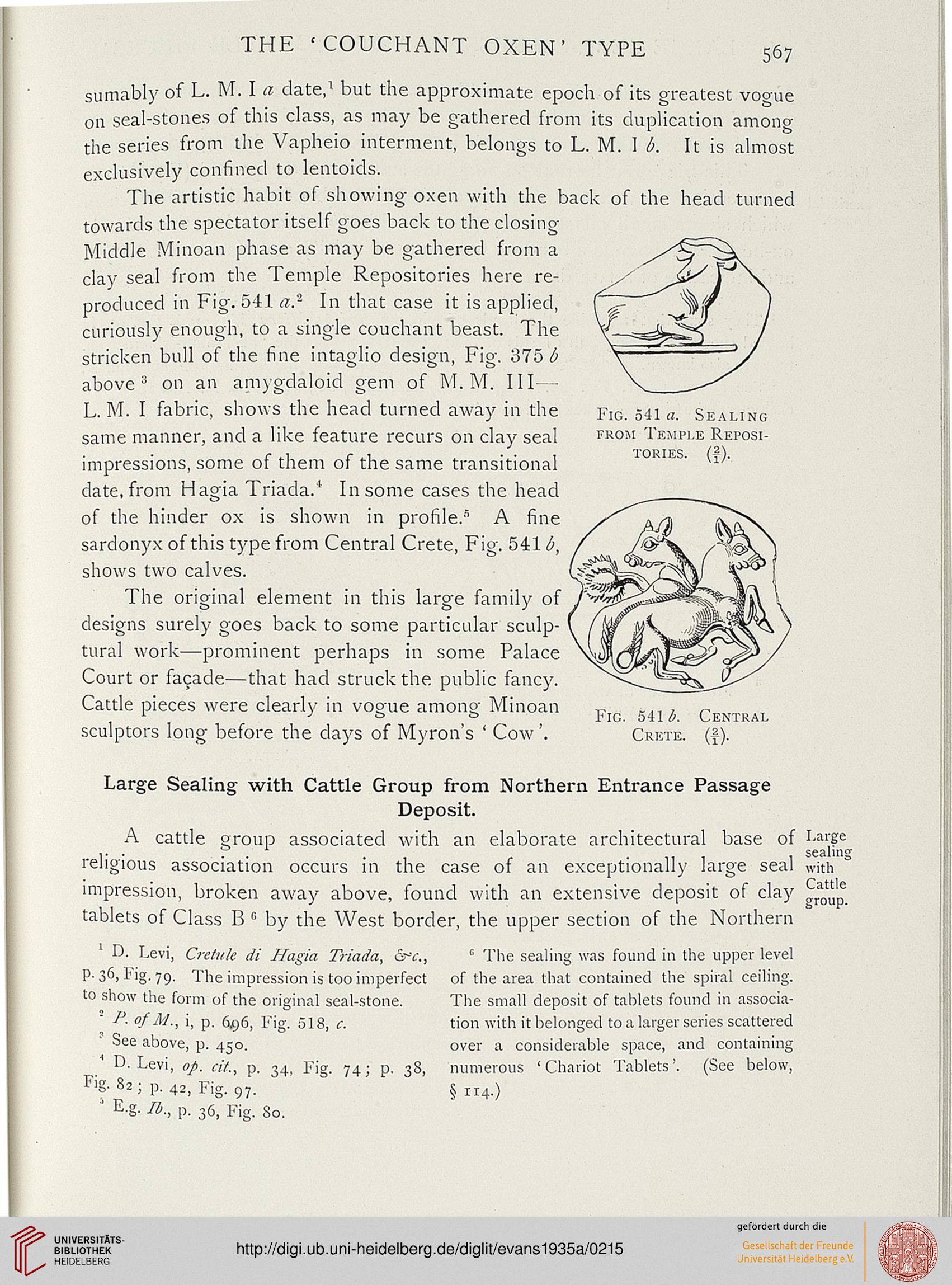THE 'COUCHANT OXEN' TYPE
567
sumably of L. M. I a date,1 but the approximate epoch of its greatest vogue
on seal-stones of this class, as may be gathered from its duplication among
the series from the Vapheio interment, belongs to L. M. 1 b. It is almost
exclusively confined to lentoids.
The artistic habit of showing oxen with the back of the head turned
towards the spectator itself goes back to the closing-
Middle Minoan phase as may be gathered from a
clay seal from the Temple Repositories here re-
produced in Fig. 541 a.- In that case it is applied,
curiously enough, to a single couchant beast. The
stricken bull of the fine intaglio design, Fig. 375 b
above3 on an amygdaloid gem of M. M. Ill—
L. M. I fabric, shows the head turned away in the
same manner, and a like feature recurs on clay seal
impressions, some of them of the same transitional
date, from Hagia Triada.1' In some cases the head
of the hinder ox is shown in profile.'1 A fine
sardonyx of this type from Central Crete, Fig. 541b,
shows two calves.
The original element in this large family of
designs surely goes back to some particular sculp-
tural work—prominent perhaps in some Palace
Court or facade—that had struck the public fancy.
Cattle pieces were clearly in vogue among Minoan ,, „.,, ,,„„
1 J e> & Fig. 5410. Central
sculptors long before the days of Myron's ' Cow'. Crete, (f).
Fig. 541 a. Sealing
from Temple Reposi-
tories. (|).
Large Sealing with Cattle Group from Northern Entrance Passage
Deposit.
A cattle group associated with an elaborate architectural base of
religious association occurs in the case of an exceptionally large seal
impression, broken away above, found with an extensive deposit of clay
tablets of Class B " by the West border, the upper section of the Northern
D. Levi, Crctuk di Hagia Triada, &•/:.,
p. 36, l1 ig. 79. The impression is too imperfect
to show the form of the original seal-stone.
2 P.ofM., i, p. 646, Fig. 518, c.
* See above, p. 450.
' D. Levi, op. tit, p. 34, Fig. 74; p. 38,
blS- 82; p. 42, Fig. 97.
* E.g. lb., p. 36, Fig. So.
Large
sealing
with
Cattle
group.
fi The sealing was found in the upper level
of the area that contained the spiral ceiling.
The small deposit of tablets found in associa-
tion with it belonged to a larger series scattered
over a considerable space, and containing
numerous ' Chariot Tablets'. (See below,
§ 114-)
567
sumably of L. M. I a date,1 but the approximate epoch of its greatest vogue
on seal-stones of this class, as may be gathered from its duplication among
the series from the Vapheio interment, belongs to L. M. 1 b. It is almost
exclusively confined to lentoids.
The artistic habit of showing oxen with the back of the head turned
towards the spectator itself goes back to the closing-
Middle Minoan phase as may be gathered from a
clay seal from the Temple Repositories here re-
produced in Fig. 541 a.- In that case it is applied,
curiously enough, to a single couchant beast. The
stricken bull of the fine intaglio design, Fig. 375 b
above3 on an amygdaloid gem of M. M. Ill—
L. M. I fabric, shows the head turned away in the
same manner, and a like feature recurs on clay seal
impressions, some of them of the same transitional
date, from Hagia Triada.1' In some cases the head
of the hinder ox is shown in profile.'1 A fine
sardonyx of this type from Central Crete, Fig. 541b,
shows two calves.
The original element in this large family of
designs surely goes back to some particular sculp-
tural work—prominent perhaps in some Palace
Court or facade—that had struck the public fancy.
Cattle pieces were clearly in vogue among Minoan ,, „.,, ,,„„
1 J e> & Fig. 5410. Central
sculptors long before the days of Myron's ' Cow'. Crete, (f).
Fig. 541 a. Sealing
from Temple Reposi-
tories. (|).
Large Sealing with Cattle Group from Northern Entrance Passage
Deposit.
A cattle group associated with an elaborate architectural base of
religious association occurs in the case of an exceptionally large seal
impression, broken away above, found with an extensive deposit of clay
tablets of Class B " by the West border, the upper section of the Northern
D. Levi, Crctuk di Hagia Triada, &•/:.,
p. 36, l1 ig. 79. The impression is too imperfect
to show the form of the original seal-stone.
2 P.ofM., i, p. 646, Fig. 518, c.
* See above, p. 450.
' D. Levi, op. tit, p. 34, Fig. 74; p. 38,
blS- 82; p. 42, Fig. 97.
* E.g. lb., p. 36, Fig. So.
Large
sealing
with
Cattle
group.
fi The sealing was found in the upper level
of the area that contained the spiral ceiling.
The small deposit of tablets found in associa-
tion with it belonged to a larger series scattered
over a considerable space, and containing
numerous ' Chariot Tablets'. (See below,
§ 114-)





